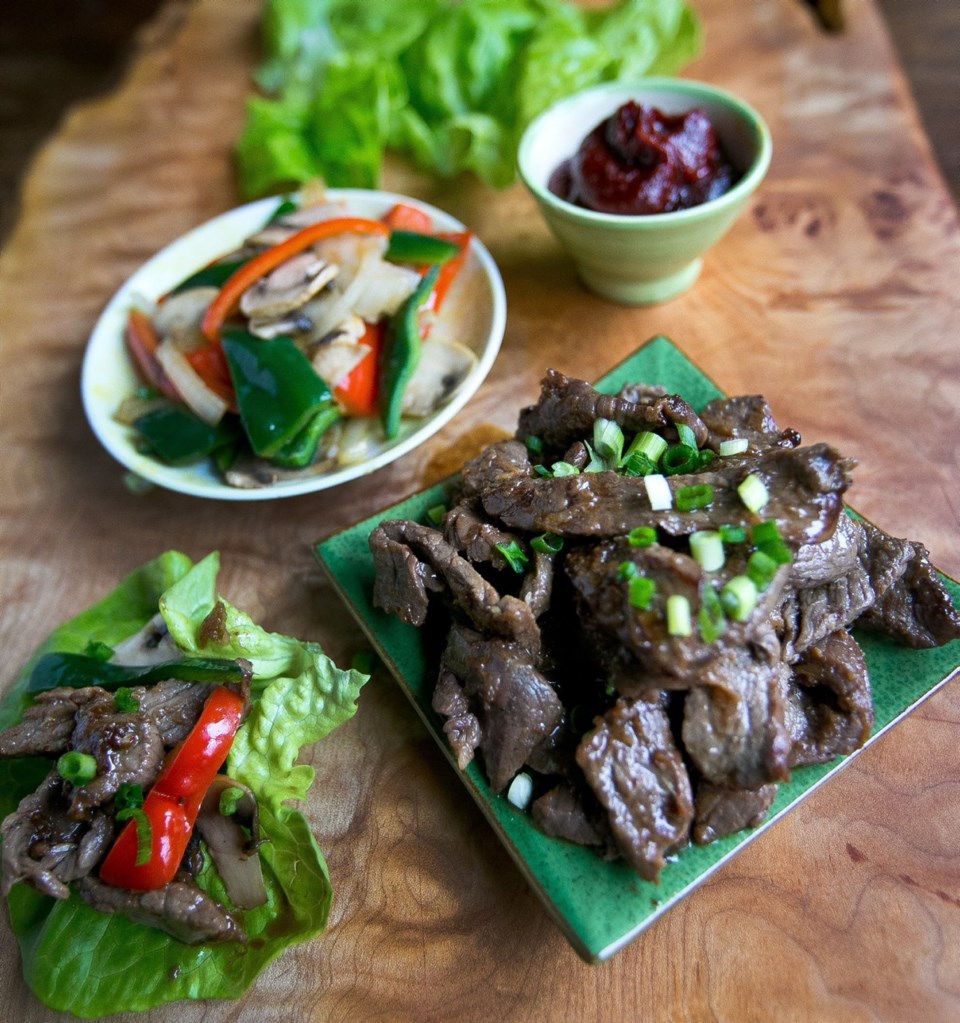 Dear Eric: Can you tell me what bulgogi is? I’ve been hearing that name on cooking shows. I think it’s Asian, but one chef in a food truck made tacos with it.
Dear Eric: Can you tell me what bulgogi is? I’ve been hearing that name on cooking shows. I think it’s Asian, but one chef in a food truck made tacos with it.
Matt
Dear Matt: I can understand your confusion, because bulgogi is a Korean dish, not a Mexican one. But we live in a world where cuisines can sometimes successfully merge, such as serving bulgogi on a tortilla.
Before I tell you why that could work, let me first tell you what bulgogi is.
The Korean word bulgogi literally means, “fire meat.” Bul signifies the flame, gogi the meat. The term makes sense because bulgogi is traditionally made by grilling beef, such as sirloin, over a glowing fire. These days, though, a well-heated stovetop grill pan, griddle, wok or skillet can also be used to cook the meat.
Before cooking, the meat is sliced and marinated with such things as soy sauce, garlic, ginger, sugar and sesame oil. Grated pear and/or onion are also sometimes added to the marinade because their enzymes can help further tenderize the meat.
Before grilling it over a fire, the sliced meat is placed in a grill basket, perforated dome griddle or other device that will prevent the meat from slipping into the fire. If it’s being cooked on one of the stovetop pans noted above, that won’t be a concern.
Bulgogi is sometimes served or cooked with grilled or stir-fried vegetables, such as onions, bell peppers, mushrooms and garlic.
It is also sometimes served with raw vegetables, such as thinly sliced cabbage, daikon, carrot and cucumber, and a condiment or fermented food, such as kimchi or ssamjang, a soy bean/red pepper paste. You can also serve steamed rice with bulgogi.
Bulgogi and the items noted above are often served with lettuce leaves or other leafy greens you can use to wrap up the pieces of meat and other items you’ve served with it.
It’s that wrapping of the meat in something fairly neutral-tasting that makes bulgogi an item that could also work in a tortilla. Tacos are often stuffed with a flavourful meat mixture, so why not bulgogi topped with a few of the ingredients noted above?
Matt, in my recipe I decided to serve the bulgogi with lettuce leaves, stir-fried vegetables and a spicy condiment. It tasted delicious and went well with cold beer.
Bulgogi
This is my version of bulgogi. The meat is extremely flavourful, aromatic and wonderful wrapped up in the lettuce leaves with the vegetables and spicy condiment. You could also serve steamed rice with the bulgogi.
Preparation time: 35 minutes, plus 4 to 8 hours marinating time
Cooking time: About 3 minutes
Makes: 4 servings
1/3 cup soy sauce
2 Tbsp mirin, sake or dry sherry (see Note 1)
2 Tbsp sesame oil
2 tsp granulated sugar
2 medium garlic cloves, minced
1 Tbsp finely grated fresh ginger
1/4 cup coarsely grated Asian, Bartlett or other pear
1/4 cup coarsely grated onion
• freshly ground black pepper to taste
1 1/3 lbs. (about 600 grams) top sirloin steak, cut into thin 8- to 10-centimetre strips
2 Tbsp vegetable oil
2 green onions, thinly sliced
1 head butter lettuce, cored and separated into leaves
• ssamjang (a soy bean/chili paste) or hot Asian-style chili sauce, such as Sriracha, to taste (see Note 2)
• stir-fried vegetables (see Note 3)
Combine the first nine ingredients in a non-reactive (non-aluminum) bowl. Add the beef and toss to combine. Cover, refrigerate and marinate beef four to eight hours.
Drain marinade from the meat and discard marinade.
Heat the oil in a large stovetop grill pan, griddle, wok or heavy skillet set over high heat. When smoking hot, add the beef (watch for splatters) and cook and stir until nicely browned, about three minutes. Transfer to a serving dish and sprinkle with green onions.
Set the bulgogi on the dining table with the lettuce, ssamjang or chili sauce and stir-fried vegetables. Let diners fill and wrap their lettuce leaves as desired.
Note 1: Mirin is a sweet rice wine sold in the Asian foods aisle of many supermarkets. You’ll also find it at Asian food stores.
Note 2: Ssamjang is sold at Korean food stores. To find those stores, do a web search for Korean food stores in Victoria.
Note 3: To make the stir-fried vegetables, heat 2 Tbsp vegetable oil in a large skillet or wok set over medium-high. When hot, add to the pan 1 medium onion, halved and sliced, 1 medium red and green bell pepper, each cut into thin strips, 6 to 8 mushrooms, thinly sliced, and 1 minced garlic clove. Stir-fry three to four minutes, spoon into dish and serve with the bulgogi.
Eric Akis is the author of the hardcover book Everyone Can Cook Everything. His columns appear in the Life section Wednesday and Sunday.



